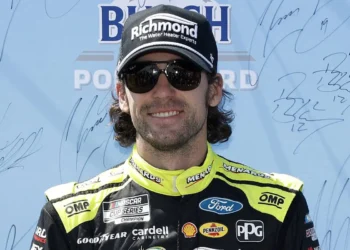Dale Earnhardt Sr., the “Intimidator,” was renowned for his fierce rivalries on the track, particularly with emerging stars like Jeff Gordon. These intense battles not only made NASCAR thrilling but also left an indelible mark on the sport’s history. Yet, beyond the rivalries and triumphs, Earnhardt’s legacy is most profoundly felt in the evolution of NASCAR’s safety standards—a transformation catalyzed by tragedy.
“Rivalry with Jeff Gordon: Sparks on the Track”
When Jeff Gordon burst onto the NASCAR Cup scene in 1992, Earnhardt was at the peak of his career. Their rivalry reached its boiling point during the 1993 season, highlighted by an infamous incident at Phoenix Raceway involving Gordon, Earnhardt, and Ken Schrader. Reflecting on the crash, Earnhardt acknowledged his mistake with a dose of humor and humility:
“I learned something from it. I got into Schrader earlier, and then Gordon later. Learned you can’t wreck two team cars in one race—they’ll team up on you.”
Gordon, despite the wreck, displayed grace, saying in a 1994 post-race interview:
“I don’t think I can ever forget last year, but I forgive [him]. We race each other real hard, and things happen out there.”
These moments defined their rivalry, showcasing a blend of competitive fire and mutual respect that electrified fans.
“Ernie Irvan’s Accident: A Sobering Perspective”
While Earnhardt relished hard racing, he drew a line when it came to crashes that resulted in serious injuries. He cited Ernie Irvan’s devastating 1994 accident at Michigan Speedway as a stark reminder of the sport’s dangers. Irvan’s near-fatal crash, which left him with a traumatic brain injury, united the NASCAR community in support of a driver once labeled as reckless.
“After the race, everybody gets over it. Somebody gets hurt like Ernie did, and everybody pulls together,” Earnhardt said. “Over a year ago, everybody was badmouthing him. Now we want to see him back.”
Irvan’s miraculous return to racing in 1995 symbolized the resilience of drivers and the risks they willingly embraced.
“The 2001 Daytona 500: NASCAR’s Darkest Day”
Tragedy struck NASCAR on February 18, 2001, during the Daytona 500. On the final lap, Earnhardt was involved in a fatal crash with Ken Schrader, suffering a basilar skull fracture—the same injury that had claimed three drivers the previous year. The death of the 7-time champion sent shockwaves through the sport, leaving an unfillable void and spurring a reckoning with safety.
Kevin Harvick, who replaced Earnhardt at Richard Childress Racing, summarized the impact of Earnhardt’s death:
“The impact that he has had after his death on the safety of this sport has been something far greater than would have happened with anybody else.”
“A Legacy of Safety”
Earnhardt’s death became the catalyst for sweeping safety reforms in NASCAR, transforming how drivers were protected:
- HANS Device (2001): Mandated to prevent fatal head and neck injuries by synchronizing head and body movement during impacts.
- SAFER Barriers (2002): Energy-absorbing walls reduced the severity of crashes.
- Car of Tomorrow (2007): Enhanced chassis designs to improve crash resistance.
Since Earnhardt’s passing, no driver has lost their life on a NASCAR track, a testament to the lasting changes his tragedy inspired.
“A Legacy Beyond the Track”
Dale Earnhardt Sr.’s rivalries and dominance embodied the spirit of NASCAR, but his ultimate legacy lies in making the sport safer for generations to come. His fiery competitiveness, paired with his humanity, continues to inspire drivers and fans alike.
NASCAR has not only preserved his memory but ensured that his loss would be the last of its kind—a profound tribute to the Intimidator’s enduring influence.













